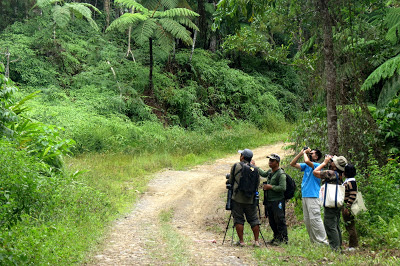 |
| One of our boats with Sta. Cruz Island in the background. |
 |
| The stretch of Grand Sta. Cruz Island's beach with its pink-speckled sand |
The Great Sta. Cruz Island is also known as the "pink beach" because its sand is finely dotted with pink. The pink speckles are bits and pieces from the red organ pipe corals which can be found in the area.
 |
| Small pieces of the red organ pipe coral |
We left the boats and went straight to look for the Tabon Scrubfowls that have been seen on the island. We peered into the brush, focusing on the ground where the birds would forage for food. The birds would usually be seen foraging close to the beach early in the morning, sometimes accompanied by chicks. Since it was already a bit late in the morning, we decided to go in the trail to look for the birds. We didn't see them but we were shown their nest: a huge mound of soil with numerous holes.
 |
| The large, communal nest of the Tabon Scrubfowls |
 |
| The nest was dotted with holes like this where the Tabon Scrubfowl lay their eggs. The chicks dig their way out when they are hatched. |
After a short viewing of the nest, we made our way out to the beach again. Our guides decided to take us to another part of the island where the birds have also been seen. We rode our boats again and the high tide took us through the mangroves. We disembarked and found our way into a trail. The ground was covered by a thick layer of dry, crispy leaves which crunched loudly under our feet.
 |
| The "trail" we entered, perfect for the scrubfowl |
Jops saw one Tabon Scrubfowl foraging in an open area but it quickly disappeared in the vegetation. Gina went on ahead with our guide, Richard, and they were able to see two individuals who were flushed into flight. I was silently praying I would be able to see one bird, but I wasn't keeping my hopes up... I felt each step I made was so noisy with all the crackling leaves.
Then I saw some movement... I trained my binoculars on the area on the ground and I saw them: two Tabon Scrubfowls, busy foraging beside each other. They were big, gray birds with small heads and fleshy faces... a bit turkey-like to me. I can't really say they were beautiful birds but it was great seeing them just the same.
The pair walked deeper into the thick brush, disappearing from sight. No photos of these shy birds. They used to be hunted and their eggs collected and sold, so they have sadly become wary of humans. The Department of Environment and Natural Resources have intervened and now they are no longer bothered by the people living on the island. The Tabon Scrubfowls are now reported to be breeding and more numbers have been reported.
We soon left and boarded our boats again to return to the main beach. We dropped by the bat area where over a thousand Malayan Flying Foxes roost during the day.
 |
| Some of the Malayan Flying Foxes Pteropus vampyrus |
We headed back to the beach and had a snack of steamed crabs. We birded some more in the immediate area seeing Oriental Magpie-Robins, Olive-backed Sunbirds, Pied Fantails, Pied Trillers, Golden-bellied Flyeaters, and Jops got better views of another Tabon Scrubfowl.
I wish we had more than a few hours to relax and enjoy the island but we had to say goodbye. Sta. Cruz Island is such a quiet and beautiful place (plus it has Tabon Scrubfowls!) I'd love for a chance to go back and just swim, lie on the beach, and find the scrubfowls again.













































